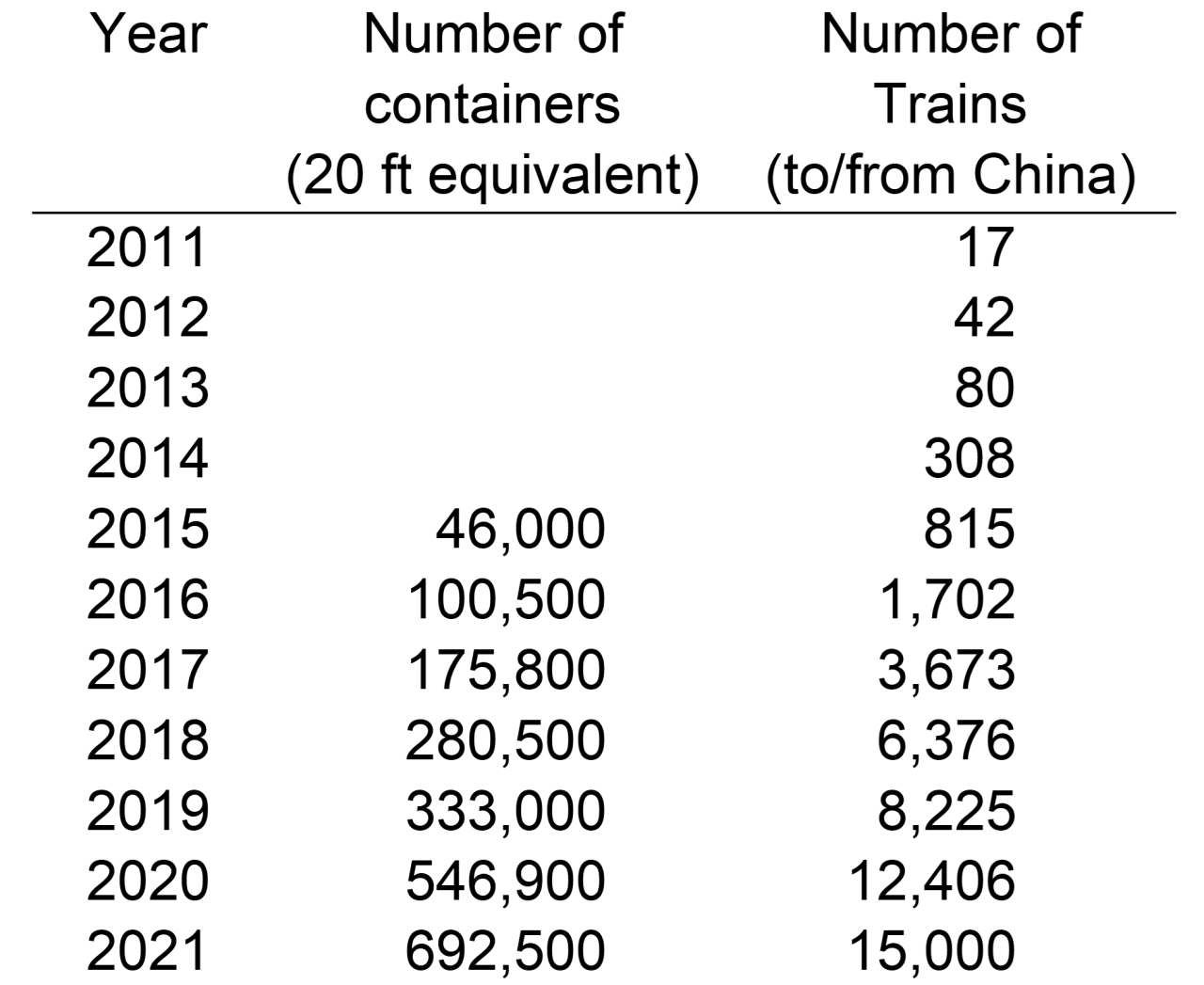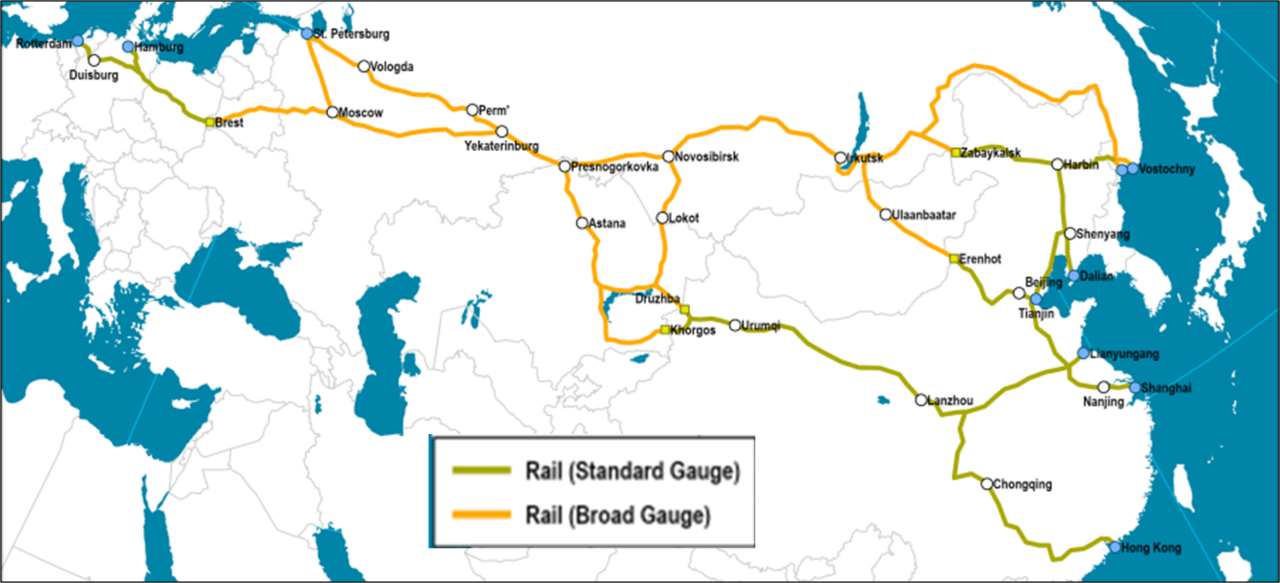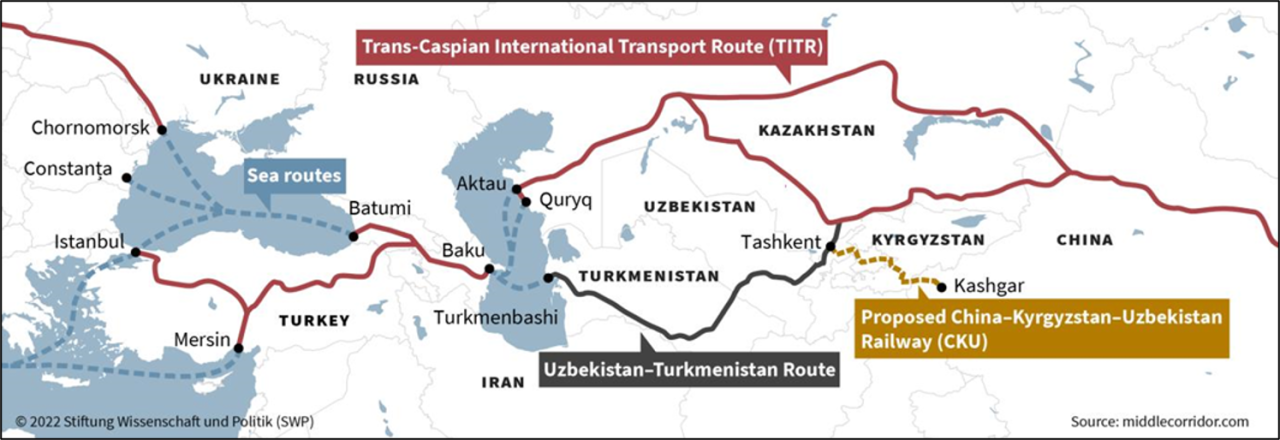This post draws from a paper to be presented in the ACAES session on Asian Economies in Global Supply Chains at the 2023 Allied Social Science Association Annual Meeting, program here.
International supply chains are dependent on ease of crossing borders and efficient connectivity in terms of price, speed, and reliability. The intensification of international supply chains during the last four decades has been easier in some parts of the world than others and so-called global value chains have been primarily regional value chains (RVCs), centered on East Asia, Europe, and North America (Johnson & Noguera, 2017). The RVCs were only linked at the final step of sending finished products to markets in high-income countries, typically by ocean shipping. The Eurasian rail Landbridge established the first major overland link between RVCs, and traffic grew rapidly from 2011 to 2021.
Efficient supply chain management relies on just-in-time delivery and minimization of inventories whether held at production points or in transit. Rail is faster than sea transport and has more reliable arrival times, while maritime freight rates are lower. For European car companies sending components to factories in China and for electronics firms sending computers and printers from China to their European marketing centers, the benefits outweighed the higher costs of rail freight.
Nonstop rail services between China and Europe were established in the 2010s to meet this demand. As services and routes expanded, the number of customers increased.
Development of the Landbridge was market-driven (Pomfret, 2018). However, it relied on governments to agree on transit rules and on the (state-owned) rail companies to collaborate over schedules and rates.
The Landbridge flourished despite shocks such as deteriorating EU-Russia relations after 2014, shifting EU-China political relations after 2017, and the COVID-19 epidemic in 2020-21 (Pepe, 2021).
International trade was negatively impacted by the COVID-19 epidemic, but the impact on different modes of transport varied. In Russia, Central Asia, and the Caucasus, air freight essentially stopped and transport by road was disrupted by requirements for drivers to be tested for COVID at borders and other regulations. Sea freight was disrupted by quarantine and other restrictions that stranded ships in the wrong place. Journey time for cargo from East Asia to Europe increased from less than 60 days in 2019 to over 100 days by the end of 2021 (flexport). Unreliability of maritime delivery times was highlighted by closure of the Suez Canal in March 2021 after the Ever Given container ship became wedged.
|
Table 1: Traffic on China-EU Container Trains
Data sources: United Transport and Logistics Company; Railfreight.com. |
Rail transport was less affected by anti-COVID measures, and acceleration of digitalization and paperless trade may even have improved the efficiency of international rail transport. Many manufacturers, distributors, and logistics agents, who had previously relied upon maritime transport between East Asia and Europe, turned to overland freight routes. The number of containers shipped between China and EU by rail increased from 333,000 in 2019 to 546,900 in 2020 and to almost 700,000 in 2021, as shown in Table 1.
With success, a danger is that a key transit country might use its monopoly power to increase prices. The main Landbridge routes all passed north of the Caspian Sea and transited Russia, as shown in Map 1. China and, to a lesser extent, the EU sought to develop alternative routes to deter hold-up actions along the northern route, although routes across the Caspian Sea, shown in Map 2, or south of it had significant disadvantages.
|
Map 1: The Eurasian Landbridges |
|
Map 2: The Middle Corridor Source: German Institute for International and Security Affairs |
In fact, the potential for disruption was dramatically and unexpectedly revealed in 2022 after Russia’s invasion of Ukraine.
Financial and economic sanctions imposed by the USA and the EU on Russia on 25 February meant that European companies could face issues with money transactions when doing business in Russia. A few days later, both the EU and USA included Russian Railways in their sanctions lists. Customers began abandoning the northern corridor, concerned about the legal implications of working with a sanctioned company and about potential problems such as insurance coverage being invalidated by "Act of War" clauses.
The actual situation is difficult to assess. Rail connections continued to function, subject to additional procedures to check sanctions compliance and, although international payments to Russian railways could be difficult, freight charges could be paid in China (RailFreight.com).
Alternatives to transiting Russia were sought immediately. In late February 2022, a train went from China to Istanbul and then the containers went by sea to Trieste. Middle Corridor routes cross the Caspian Sea from Central Asia to Baku and then either use rail to Georgia and sea to Romania or rail to Istanbul and sea to an EU port to avoid passing through non-EU members in southeast Europe (RailFreight.com).
Changes of transport mode lengthen the journey, reducing the benefits of rail over sea. Prior to Russia’s invasion of Ukraine, less than 5% of Landbridge traffic used the Middle Corridor. Scaling up faces capacity constraints associated with the Caspian Sea crossing as well as congestion at Constanta port and on parts of the Turkish rail network.
On 31 March 2022, Georgia, Azerbaijan, Turkey, and Kazakhstan agreed to create a joint venture that would provide high-quality intermodal transport and logistics services, harmonize cross-border rates, and introduce a unified IT platform to fully automate cargo transport services from China to Turkey and at Black Sea ports.
The EU moves more slowly than China or the Middle Corridor countries, but it too has increased focus on the Middle Corridor.
In the longer term, currently difficult routes south of the Caspian Sea could be feasible. A route through Uzbekistan and Turkmenistan to Iran could connect to the Turkish rail network or to Iran’s ocean ports. A railway linking Kashi, the furthest west point in China’s rail network, to Uzbekistan, will provide an alternative east-west route to the Caspian, avoiding both Russia and Kazakhstan (Ports Europe, 2022).
The rapid evolution of the Landbridge highlighted the importance of appropriate connectivity for international supply chains. The Landbridge remained robust to potential threats of disruption in 2014 and 2020, but the Russia-Ukraine war in 2022 highlighted the dangers of relying on a system with a chokepoint. Rapid responses to the war-driven disruption reflected the demand for Eurasian rail services and the potential win-win gains for service providers as well as customers.
This post has focused on exogenous shocks, but the long-term prospects for rail connections between China and Europe are positive. Electric trains along well-maintained track are a more environmentally friendly mode of international transport than ships or planes.


